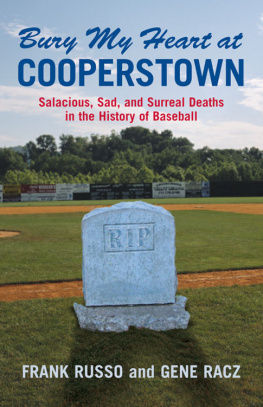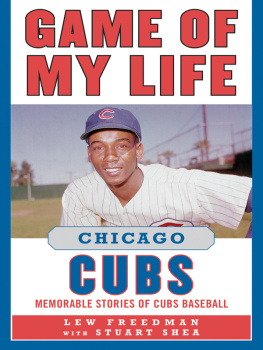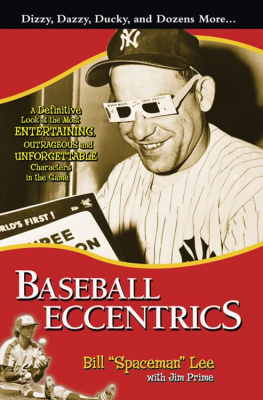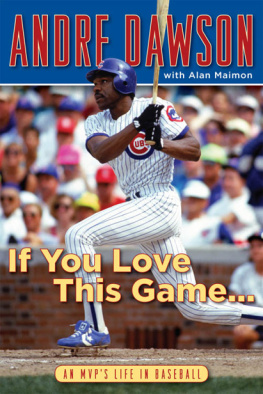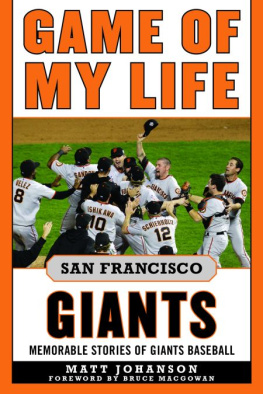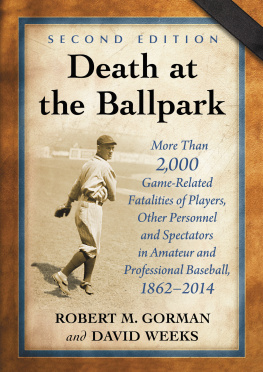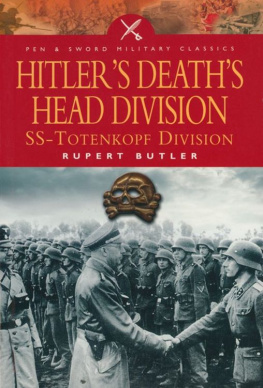Dedication
To my wife and partner, Joanne, who believed in me from practically the first moment we met and told me to never quit. To my mother, Rose, who has always been there for me! Guess what, we did it! To all my nieces and nephews, thanks from Uncle Frank! To all my in-laws, especially Rick DiCanio and Kurt Nellis, both of whom helped out with info and fascinating tidbits! Thank you to my mother-in-law, Vita DiGiovanni.
This book is also dedicated to the memory of my father, Frank, brother Joseph and sister Elaine, who are always with me in spirit. Also to the memories of my little ones, Podey, Pinky, and Babe, who crossed over while this work was being created. Also a special thanks to Dr. Neal Beeber of the Rutherford Animal Hospital, one of the great Yankees fans that I know. Yeah, I know, I am always fashionably late!
Thanks to Timmy and Barbara South. Hey Tim, will we ever live down the famous Fabian Kowalik incident at the HOF library?
This book is also dedicated to Kenny Gunny Dawson, USMC retired, and all the men and women of the United States Armed Forces fighting the real struggle of good versus evil.
To the Coach, Robin Gunn and Trish Hackler, my two dear friends in Florida who always remind me how warm it is down there when its 12 degrees in the middle of December.
Frank Russo
To my loving parents, Zoltan and Eleanor, who always gave me the home-field advantage; my beautiful wife, Angie, who continues to keep me in the lineup despite my occasional slumps; and my sons, Alden and Garrettthey come ready to play every day.
Gene Racz
TB or Not to Be
Perhaps the most famous ballplayer to succumb to tuberculosis (TB) was the legendary Christy Mathewson. Sadly, he was close to controlling his first bout with TB after going to a cure house in Saranac, New York, where the pristine, oxygen-rich air of the Adirondack Mountains was thought to have healed him.
His premature return to Boston to take a job caused his demise.
Another Hall of Fame pitcher, Rube Waddell, and prolific umpire Hank ODay were among the many others taken by the cruel and insidious disease.
During the 19 th and early 20 th centuries, TBalso called consumption and phthisis (Greek for consumption)was the leading cause of death in the United States. In its victims, TB usually progresses from a dry, persistent cough to fatigue, night sweats, and finally a general wasting away, with acute hemorrhages of blood from the lungs. Typically, but not exclusively, TB is a disease of the lungs caused by the bacillus Myobacterium tuberculosis.
Tuberculosis is the most common infectious disease in the world today. Luckily, 90 percent of the nearly two billion infected on the planet carry only a latent form of TB that is controlled by the bodys immune system and is not contagious.
Still, active TB strikes down 23 million annually worldwide.
Prior to the 1940s, there were no reliable drugs available for the treatment of TB. Most often, doctors advised their patients to rest, eat well, and exercise outdoors. Those who survived their first bout with the disease were often haunted by severe recurrences that destroyed any hope for an active life. It was estimated that, at the turn of the century, 450 Americans died of TB every day, most between ages 15 and 44.
At that time, the vast majority of the victims were the poor in urban settings, where crowded and often filthy living conditions provided a fertile environment for the airborne spread of the disease. In the days before treatment, victims of TB were often stigmatized and ostracized. They were called derisive names such as Lunger, and the terrifying threat of the contagion made the tubercular invalid an untouchablea complete outcast. Many lost their jobs because of the panic they created among coworkers. Some landlords refused to house them. Hotel proprietors, forced to consider the safety of other guests, turned them away. All but rejected by society, TB victims gathered in secluded TB hospitals and headed for treatment to sanatoriums, where large percentages of them died.
Doctors today can successfully treat TB with a combination of antibiotics, provided the medicine is administered for a prolonged period.
Christy Mathewson
Perhaps the most famous baseball player to ever die of the dread disease, Christy Mathewson was the games first 20 th -century idol.
Winner of 373 games, holder of numerous records, and arguably the best pitcher of his era, Mathewson was a man of great character. Smart and handsome, he was adored by fans. His teammates and opponents respected his competitive edge.
In the end, his incredible drive and will to succeed may have caused his demise when he prematurely returned to work when convalescing from TB.
Many people have surmised that Mathewsons accidental exposure to poison gas during a training exercise in France during World War I weakened his lungs to a point where they became more susceptible to the disease. In the army, he served in the chemical warfare unit with his buddy, Ty Cobb.
Upon his return from the war, he went back to the game as a coach for the Giants but had to retire from the game after just one season when he learned that he had contracted TB the same disease that killed his brother Henry a few years earlier. Mathewson went for treatment at Saranac Lake, New York, where Dr. Edward Livingston Trudeau had set up the famous Adirondack Cottage Sanatorium in 1885 to help treat consumptives.
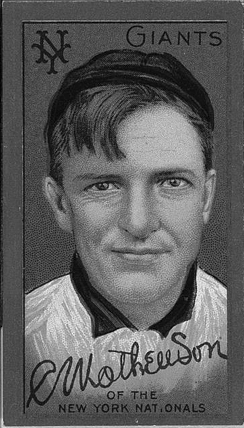
Baseball card image courtesy of the Library of Congress.
Known to many as the Adirondack Cottage Cure, a regimen of diet and exercise was prescribed amid the pristine, oxygen-rich mountain air. Mathewsons health improved greatly during his long stay there, and had he continued on with his course of treatment, he most surely would have been able to enjoy a long and healthy life.
Unfortunately, his competitive baseball juices got the best of him, and he took the position of president of the Boston Braves in 1923. Working in the dirty air of an urban area in cramped and much more stressful conditions, TB took hold of him again. By the spring of 1925, his health had begun to take a step backward, and he returned to Saranac Lake in early July in the hopes of once again finding a miracle in the mountain air.
It was too little, too late.
By that fall, Mathewson was bedridden and died on Wednesday night, October 7, 1925, with his wife Jane by his side.
News of his death spread like a somber cloud, enveloping the baseball world that should have instead been celebrating the World Series between Washington and Pittsburgh. Matty was mourned like no player before him. When news of his passing reached two of his closest friends in the game, Walter Johnson and Ty Cobb, both men were driven to tears. Cobb spoke the following poignant words: He was my friend and I shall miss him dearly. You couldnt help but love Matty.
Mathewson was laid to rest at the Lewisburg City Cemetery in Lewisburg, Pennsylvania, in the area known as the Path of Love.
Alex Farmer
New York City native Alex Johnson Farmer appeared in 12 games for the 1908 Brooklyn Dodgers, batting only .167. In his final game on September 29a 52 loss to the Boston Doves at Bostons South End Groundsseven Boston players stole bases, prompting the hometown paper, the Boston Globe, to note, The home team won on its base running; Farmer, the catcher, showing wretched form in throwing to bases. Not the most memorable swan song in baseball history, although Farmer did smack a double during the game.
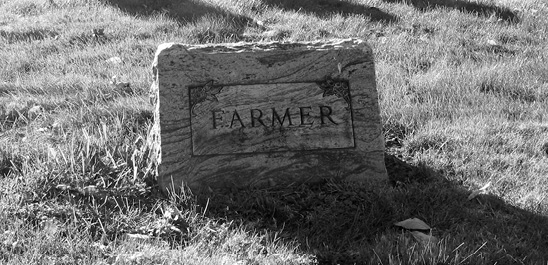
Next page
